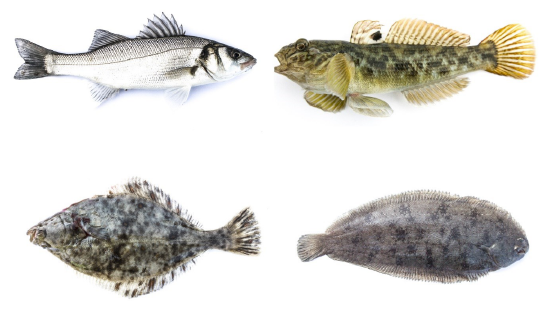3.1: Introduction to Fin Fish, Flat Fish and Round Fish
- Page ID
- 21239
Fish are aquatic vertebrates with fins for swimming and gills for breathing. Of the more than 30,000 species known, most live in the seas and oceans; freshwater species are far less numerous. Shellfish are aquatic invertebrates with shells or carapaces. They are found in both fresh and salt water.
Always an important food source, fish and shellfish have become increasingly popular in recent years, due in part to demands from health-conscious consumers. Because of increased demand and improved preservation and transportation techniques, good-quality fish and shellfish, once found only along seacoasts and lakes, are now readily available to almost every food service operation.
Many fish and shellfish species are very expensive; all are highly perishable. Because their cooking times are generally shorter and their flavors more delicate than meat or poultry, special attention must be given to fish and shellfish to prevent spoilage and to produce high-quality finished products

STRUCTURE and MUSCLE COMPOSITION
The fish and shellfish used in food service operations can be divided into three categories: fish, mollusks and crustaceans.
Fish include both fresh and saltwater varieties. They have fins and an internal skeleton of bone and cartilage. Based on shape and skeletal structure, fish divide into two groups: round fish and flatfish. Round fish swim in a vertical position and have eyes on both sides of their heads. Their bodies may be truly round, oval or compressed.
Flatfish have asymmetrical, compressed bodies, swim in a horizontal position and have both eyes on top of their heads. Flatfish are bottom dwellers; most are found in deep ocean waters around the world. The skin on top of their bodies is dark, to camouflage them from predators, and can change color according to their surroundings. Their scales are small, and their dorsal and anal fins run the length of their bodies.
The flesh of fish and shellfish consists primarily of water, protein, fat and minerals. Fish flesh is composed of short muscle fibers separated by delicate sheets of connective tissue. Fish, as well as most shellfish, are naturally tender, so the purpose of cooking is to firm proteins and enhance flavor. The absence of the oxygen-carrying protein myoglobin makes fish flesh very light or white in color. (The orange color of salmon and some trout comes from pigments found in their food.) Compared to meats, fish do not contain large amounts of intermuscular fat. However, the amount of fat a fish does contain affects the way it responds to cooking. Fish containing a relatively large amount of fat, such as salmon and mackerel, are known as fatty or oily fish. Fish such as cod and haddock contain very little fat and are referred to as lean fish. Shellfish are also very lean.
Identifying fish and shellfish properly can be difficult because of the vast number of similar- appearing fish and shellfish that are separate species within each family. Adding confusion are the various colloquial names given to the same fish or the same name given to different fish in different localities. Fish with an un-appealing name may also be given a catchier name or the name of a similar but more popular item for marketing purposes. Moreover, some species are referred to by a foreign name, especially on menus.
The FDA publishes a list of approved market names for food fish in The Seafood List: FDA Guide to Acceptable Market Names for Food Fish Sold in Inter-state Commerce 2002. The list is updated regularly and available on the FDA's Web site at the Center for Food Safety and Applied Nutrition. Deviations from this list are strongly discouraged but difficult to enforce. We attempt to use the most common names for each item, whether they are zoologically accurate or not.


